Madie Carroll House
Introduction
Text-to-speech Audio
Images
Illustration of Mary Carroll defending the house from Union soldiers
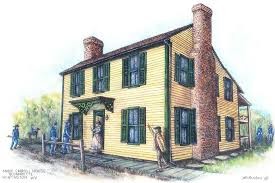
The house, circa 1970
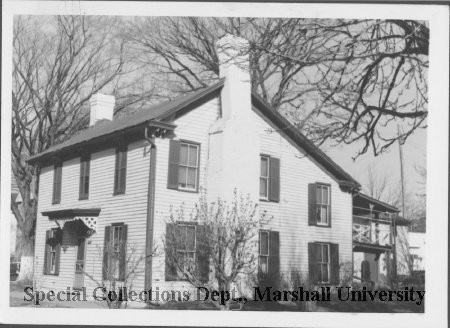
The house, circa 1989
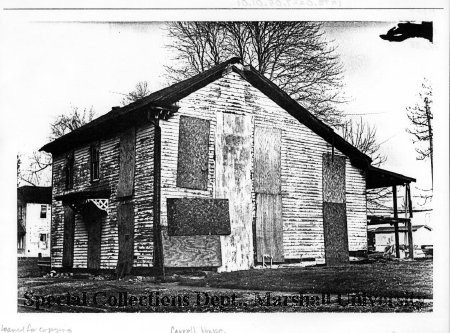
The Madie Carroll House is one of the oldest structures in Cabell County, dating back to 1810.
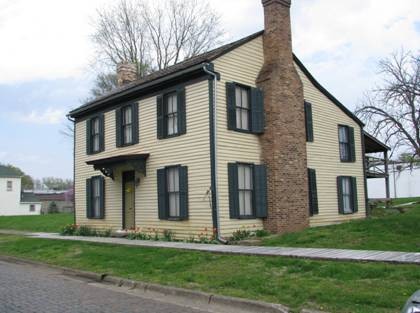
The Madie Carroll House, present-day
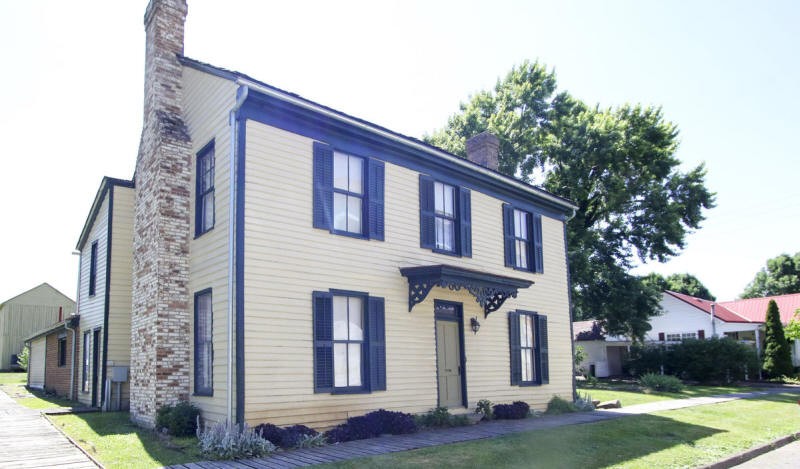
The house, pictured in 2015
.jpg)
The barn at the Madie Carroll House, before it became the Civil War Museum
.jpg)
Old hand-written label on Madie Carroll house
.jpg)
Several interpretive historical markers surround the house, detailing its history and that of the Battle of Guyandotte.
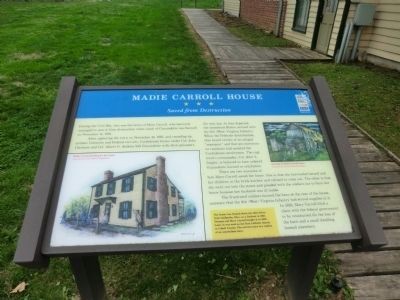
Historical marker at the Madie Carroll House

Backstory and Context
Text-to-speech Audio
Although the Madie Carroll House is one of the area’s oldest structures, it was not originally built in Cabell County or even in West Virginia. According to local histories, a river tradesman named James Gallaher obtained the dwelling in Gallipolis, Ohio and transported it by flatboat to Guyandotte, Virginia in 1810. Guyandotte itself was founded that same year when the Virginia General Assembly recognized twenty acres of land owned by Thomas Buffington as a village. James Gallaher placed the future Madie Carroll House on Lot #34 of the new town. Located at the confluence of the Guyandotte and Ohio rivers, Guyandotte soon grew into a port for steamboats on the Ohio River and a popular stagecoach stop along the James River & Kanawha Turnpike. Gallaher also became an influential citizen in the town, owning over twenty of its lots and becoming a trustee for Marshall Academy in 1838. By 1836, however, Gallaher had moved out of Guyandotte and onto a farm located between what is now 14th Street and 11th Street in Huntington.
The Madie Carroll House was occupied by several different owners before the Carroll family acquired it in 1852. Originally from Ireland, Thomas Carroll, his wife, Anne Burnes, and their children - Thomas, Michael, Austin, and Margaret - moved into their new home on November 2, 1852. After Anne died of pneumonia in her early 40s, Thomas was remarried to Mary Fee, another Irish immigrant. Thomas and Mary used their house as a boarding house, which they called the Carroll Inn. It was frequented by travelers from the Ohio River and a nearby stagecoach line. At the time, the house was a four-room building with a stone kitchen separated from the main structure by a breezeway. According to local legend, Collis P. Huntington stopped by the Carroll Inn in 1869. Huntington allegedly became angry with the town for fining him when his horse became un-tethered and ran loose in town, leading him to decide not to build his railroad terminus at Guyandotte. The Carrolls were also the first Catholic family in the area. Because a Catholic church was not built in the area until 1873, the family held the county’s first Catholic church services in their home. The first parish priest, Father Thomas Quirk, also lived in the Carroll house from 1872 to 1884.
Mary Carroll, who continued to run the inn herself after Thomas’s death, was credited with saving the house from destruction during the Battle of Guyandotte. On November 10, 1861, a Confederate force attacked a Union recruit camp at Guyandotte, but the Confederates quickly overcame the federal troops. On the morning of November 11, newly-arrived Union troops set fire to much of the town in retaliation for the strong Confederate sympathies held by many of Guyandotte’s residents. During the battle, Mary Carroll barricaded herself and her family inside the house and refused demands from Union troops to leave. Eventually the soldiers gave up and burned the family's barn instead. In 1892, Mary successfully petitioned the federal government for reimbursement for the loss of property due to the fires.
For decades, the Carroll family continued to live in the house, and Thomas and Mary’s descendants also came to own many other properties in Guyandotte. At some point in its history, the breezeway between the main house and the kitchen was closed to make a dining room, music room and hall, and a porch was added. The house was also damaged by floods on several occasions, but this problem was fixed with the construction of a floodwall along the Guyandotte River. Madie Carroll, the house’s namesake, gained possession of the home when she inherited it from her aunt Mayme. Born on July 19, 1885, Madie was the daughter of Michael Henry Carroll - a son of Thomas Carroll - and Elizabeth W. Downy. After her mother passed, Madie lived with her step-grandmother Mary along with several aunts and uncles in the Carroll House. Madie, who was a music teacher, was very proud of the house’s heritage and her family’s history. She was living in the house when it was listed on the National Register of Historic Places in June of 1973, but passed away two years later in 1975.
Following her death, the Madie Carroll House was passed on to her nephew, Lewis Carroll. On October 10, 1984, Lewis and Helena Carroll deeded the home to the Greater Huntington Parks and Recreation District. In 1988, the Madie Carroll House Preservation Society was established. That same year, the organization received permission from the city park board to restore the home as a historic house museum. The following year, the Madie Carroll House Preservation Society, Inc. incorporated and received tax exempt status. The house, which had not been extensively remodeled or modernized, was restored to its nineteenth-century appearance both inside and out. In 2008, the house’s barn was rebuilt entirely after having been damaged beyond repair in the historic flood of 1937. Located inside the rebuilt barn, the Rick Whisman Civil War Museum opened in June 2019 as part of the Madie Carroll House Preservation Society's annual Heritage Day. Today, the Madie Carroll House serves as a cultural center for historic Guyandotte. Along with its regular hours of operation, it is the focal point of the annual Guyandotte Civil War Days festival and hosts special events such as Easter egg hunts and Christmas tours.
Cite This Entry
Vaughan, Amanda et. al. "Madie Carroll House." Clio: Your Guide to History. March 23, 2020. Accessed April 21, 2025. https://theclio.com/entry/303
Sources
Bleau, Edward R. “Madie Carroll House.” National Register of Historic Places Nomination Form. October 1, 1972. Accessed July 1, 2019. http://www.wvculture.org/shpo/nr/pdf/cabell/73001898.pdf.
Morfe, Don. “Madie Carroll House: Saved from Destruction.” The Historical Marker Database. April 23, 2018. Accessed July 1, 2019. https://www.hmdb.org/marker.asp?marker=73708.
"Our Story." Madie Carroll House Preservation Society, Inc. Accessed July 1, 2019. https://madiecarrollhouse.wixsite.com/home/about?fbclid=IwAR2OucvOtX90mHzns_7edQfQNe0LnTFyZBCjWTpL4UDqpQIPQveCqJWQtR8.
https://www.facebook.com/1810MadieCarrollHouse/
https://marshall.pastperfectonline.com/photo/4766E8B5-0037-4D71-9A52-283920240231
https://marshall.pastperfectonline.com/photo/9479FD00-E72D-45C4-8D03-198473880390
http://cabellcountydoorstothepast.com/history/Madie%20Carrol%20House.htm
https://www.loc.gov/resource/highsm.31821/
https://www.loc.gov/resource/highsm.31815/
https://www.loc.gov/resource/highsm.31816/
http://www.wvculture.org/history/markers/sesqui/historiccarrollhouse.html

